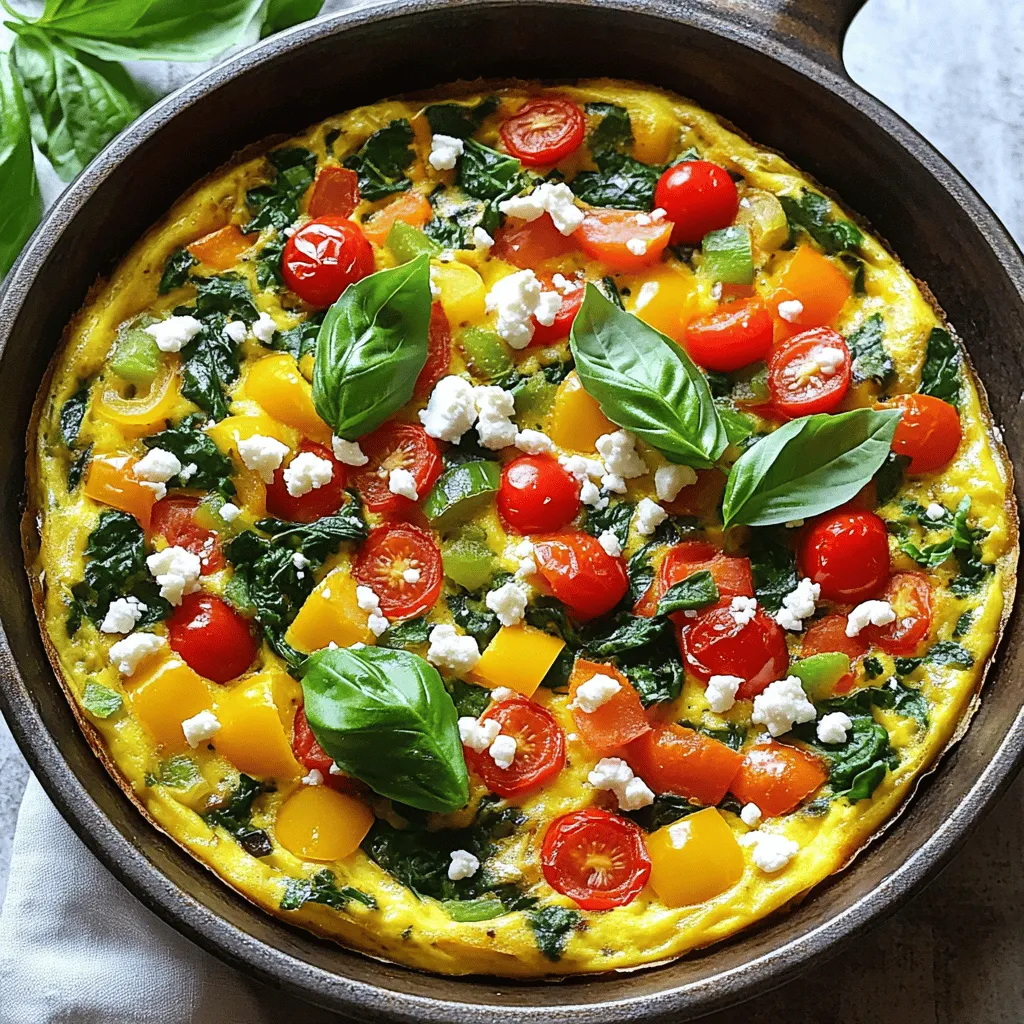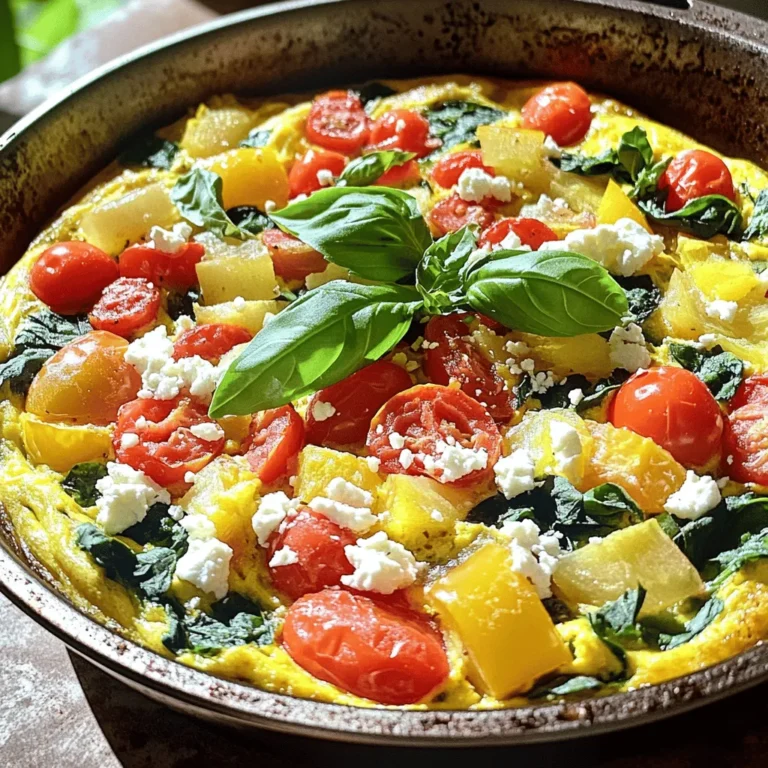Are you ready to transform your breakfast routine? The classic frittata is a delicious and easy way to pack your mornings with flavor and nutrition. With just a few fresh ingredients and simple steps, you can whip up this versatile dish that pleases everyone. Join me as we explore this tasty recipe, packed with tips and ways to customize it to fit your taste. Let’s get started—your next breakfast favorite awaits!
Ingredients
List of Ingredients for Classic Frittata
For a tasty frittata, gather these ingredients:
– 6 large eggs
– 1/4 cup milk (whole or low-fat)
– 1 cup fresh spinach, chopped
– 1/2 cup cherry tomatoes, halved
– 1/2 cup bell peppers (any color), diced
– 1/4 cup red onion, finely chopped
– 1/2 cup feta cheese, crumbled
– 1 tablespoon olive oil
– Salt and pepper, to taste
– Fresh basil leaves, for garnish
Importance of Fresh Ingredients
Using fresh ingredients makes a big difference. Fresh eggs and veggies add bright flavors and nutrition. They also improve the texture of your frittata. When you pick fresh items, the taste becomes vibrant and full. I always choose organic or local produce when I can. This choice not only supports local farmers but also gives you the best quality.
Suggested Substitutions for Dietary Needs
You can easily modify the frittata for dietary needs. Here are some ideas:
– Dairy-free: Use almond or oat milk instead of regular milk. Try vegan cheese for a dairy-free option.
– Low-carb: Skip the potatoes and focus on more veggies. Zucchini works well here.
– Protein boost: Add cooked bacon, sausage, or ham for extra flavor.
– Vegetarian: Leave out any meat and add more colorful vegetables. Mushrooms and broccoli are great choices.
These substitutions keep the frittata delicious while catering to different diets.
Step-by-Step Instructions
Preparation Steps for the Frittata
Start by gathering all your ingredients. You will need eggs, milk, and fresh veggies. I like to use spinach, cherry tomatoes, bell peppers, red onion, and feta cheese. You can mix and match based on what you like.
1. Preheat the oven to 375°F (190°C). This ensures your frittata cooks evenly.
2. Whisk the eggs: In a large bowl, mix together six large eggs, a 1/4 cup of milk, and a pinch of salt and pepper. You want it well blended. Whisk until it looks frothy.
3. Chop your veggies: Dice the bell peppers and finely chop the red onion. Halve the cherry tomatoes and chop the spinach.
Cooking Techniques and Tips
Using a skillet that can go in the oven is key here. I recommend a cast iron skillet for even cooking.
1. Heat the skillet: Place it on medium heat and add 1 tablespoon of olive oil. Let it heat until it shimmers.
2. Sauté the veggies: Add the chopped onion and bell peppers first. Cook for about 3-4 minutes. You want them soft and fragrant.
3. Add the spinach and tomatoes: Stir in the spinach and halved tomatoes. Cook for about 2 minutes until the spinach wilts.
Baking Instructions and Temperature Guidelines
1. Combine everything: Carefully pour the egg mixture over the veggies in the skillet. Tilt the skillet to spread it evenly.
2. Top with feta: Sprinkle 1/2 cup of crumbled feta over the eggs. This gives it great flavor.
3. Stovetop cooking: Cook on the stovetop for about 3-4 minutes. The edges should start to set.
4. Bake it: Move the skillet to your preheated oven. Bake for 15-20 minutes. It’s done when it puffs up and a knife inserted in the center comes out clean.
5. Cool and serve: Take it out of the oven and let it cool for a few minutes before slicing. Garnish with fresh basil if you like.
This frittata is easy to make and packed with flavor.Enjoy your cooking!
Tips & Tricks
Best Practices for a Perfect Frittata
To make a great frittata, follow these tips:
– Use fresh eggs. Fresh eggs taste better and give a fluffier texture.
– Mix well. Whisk the eggs and milk until blended. This adds air.
– Cook over medium heat. This keeps the bottom from burning.
– Don’t rush the cook time. Let it cook slowly for a tender finish.
– Let it cool slightly. This helps with easy slicing.
Common Mistakes to Avoid
Here are some pitfalls to watch out for:
– Not preheating the oven. This can lead to uneven cooking.
– Overcrowding with veggies. Too many can make the frittata soggy.
– Using low-quality cheese. Cheap cheese can alter the flavor.
– Skipping the seasoning. Salt and pepper bring out the taste.
– Removing it too soon. Make sure a knife comes out clean before serving.
Helpful Kitchen Tools for Cooking
These tools make frittata cooking easier:
– Oven-safe skillet. Ideal for stovetop to oven transfers.
– Whisk. Great for mixing eggs and milk evenly.
– Spatula. Perfect for lifting the frittata out of the skillet.
– Knife. Use a sharp knife for clean slices.
– Baking mitts. Safety first when handling hot pans!
By following these tips and tricks, you will create a delicious frittata every time.

Variations
Vegetarian Variations of Classic Frittata
A classic frittata is very versatile. You can easily make it vegetarian. Start with the base recipe and swap out the meat for more veggies. Here are some tasty ideas:
– Zucchini
– Mushrooms
– Broccoli
– Asparagus
You can add any of these veggies for great flavor and color. They all work well with eggs. Just remember to sauté them first for the best taste.
Protein Additions for Heartier Meals
If you want a heartier frittata, add some protein. You can use cooked meat or plant-based options. Here are some great choices:
– Cooked bacon
– Sausage (chicken or turkey)
– Diced ham
– Tofu
These proteins will make your frittata filling. Make sure to cook them before adding to the eggs. This step ensures they mix well with the other flavors.
Flavor Enhancers to Customize Your Frittata
Adding flavors helps make your frittata unique. Try these simple enhancements:
– Fresh herbs like parsley, chives, or dill
– Spices such as paprika or cumin
– Cheese varieties like goat cheese or cheddar
– Hot sauce or salsa for a spicy kick
Feel free to mix and match these to suit your taste. Adding different flavors can turn a simple frittata into a gourmet treat.Enjoy experimenting with your own twists!
Storage Info
How to Properly Store Leftover Frittata
To keep your frittata fresh, store it right. First, let it cool down to room temperature. Place it in an airtight container. You can also wrap it tightly with plastic wrap. This will help keep moisture in and odors out. Leftover frittata stays good in the fridge for up to four days. Just make sure it’s sealed well.
Reheating Tips for Optimal Freshness
When you’re ready to eat your frittata again, reheating is key. You can use the oven or microwave. For the oven, set it to 350°F (175°C). Place the frittata on a baking sheet for about 10 minutes. This warms it evenly and keeps it tasty. If you use the microwave, heat it in short bursts. Try 30 seconds at a time. Check if it’s warm enough before adding more time.
Freezing Instructions for Long-Term Storage
If you want to save your frittata for longer, freezing is a great option. Cut it into wedges first. Wrap each piece tightly in plastic wrap, then place them in a freezer-safe bag. This helps prevent freezer burn. You can store it in the freezer for up to three months. When you’re ready to eat, thaw it in the fridge overnight and reheat as mentioned earlier. Enjoy your Italian garden frittata again with ease!
FAQs
What is the difference between a frittata and an omelet?
A frittata and an omelet are both made with eggs, but they differ in cooking methods. An omelet cooks quickly and is folded, while a frittata cooks slowly and is baked. In a frittata, you mix the eggs with vegetables and cheese before cooking. This gives it a fluffy texture and rich flavor. The frittata is cut into slices and served, making it great for sharing.
Can I use egg substitutes in this recipe?
Yes, you can use egg substitutes in this recipe. Some popular options are silken tofu, flaxseed meal, or commercial egg replacers. These work well, but the texture and taste might change a little. If you want a similar flavor and protein, try using chickpea flour mixed with water. This can mimic the egg’s texture and richness while keeping the frittata’s heartiness.
How long does a frittata typically last in the refrigerator?
A frittata lasts about 3 to 4 days in the refrigerator. Store it in an airtight container to keep it fresh. To ensure the best taste and texture, eat it within this time frame. If you want to keep it longer, consider freezing it. Just remember to wrap it well to avoid freezer burn.
A frittata is a versatile dish that uses fresh ingredients and simple steps. We covered key ingredients, cooking techniques, and helpful tips. You can customize it for dietary needs and store leftovers easily. Whether you enjoy classic flavors or unique variations, frittatas offer endless possibilities. Keep these ideas in mind, and enjoy creating your perfect frittata every time. Embrace your culinary skills and make this dish your own.


